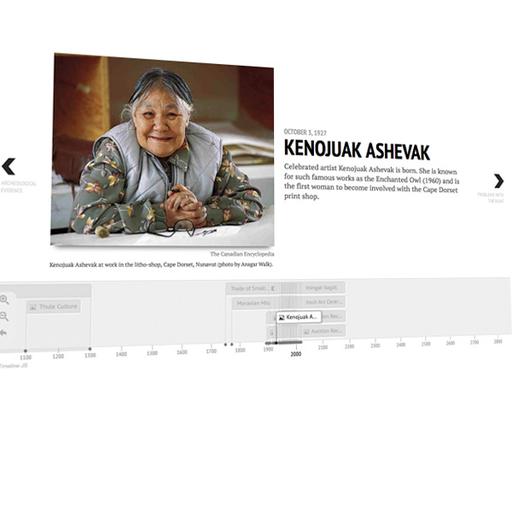Thomassie Kudlik: Payne Bay
Thomassie Kudlik: Payne Bay
There is a pre-fab plywood house in Payne Bay near where Ungava Bay opens into Hudson Strait. In this immaculately kept house, some of the ten children of Thomassie Kudlik live. Thomassie lives there also, occupying the smallest bedroom.
He uses that bedroom like an igloo. It is his sleeping quarters, “living room,” dining room, storage room and workroom. He does not use any of the space in the rest of the house, and leaves his room rarely.
The room is lit with two unshaded 200-watt light bulbs, a necessity in view of Thomassie’s weak vision. The dazzling light makes it easy to pick out objects contributing to the clean, comfortable but impressive clutter. It would be hard to crowd any more into that room.
The bed, well-used and unmade, is topped by a pillow under which are cached little plastic bags of tobacco. There is a dresser, the top of which is crowded with an elaborate old-fashioned clock, a short-wave radio and a crucifix. A handmade work table is covered with linoleum. A vise is attached so that Thomassie can work on stone with his one good arm, the other being wasted. His carving tools are neatly laid out on the table. A small blue rug is visible intermittently under many objects. A pair of rubber boots. A cane to offset the severe limp with which Thomassie walks because of a wasted leg. A pile of boxed teabags (Red Rose brand). A child’s school bag. A basin of mouldy caribou bones. A big plastic garbage pail stands beside the table.
Wads of chewed gum line the window ledge. Green kleenex is stuck in the cracks of the broken glass to keep out the wind, with moderate success. The window glass is completely frosted. On the wall hangs a hot-water bottle, dangling from a nail; also a snow-beater (a flat wooden stick used for beating snow off clothes before entering an igloo so it will not melt and wet the garments), a Hudson’s Bay Company map of the area, a very large map of Arctic Quebec, a photo blow-up of a daughter and her friend, two 1979 calendars.
Thomassie is either 69 or 74, or some other age depending on source. INUIT SCULPTURE IN THE 1970’S, the important new traveling exhibition in which Thomassie is honoured with inclusion of two of his sculptures, says he was born in 1910. His daughter, Mary Thomassie, believes he is 74. No matter.
He would still be the very calm appearing person that he is. He wears a small, neat moustache and trims his grey hair high up on the sides of his head. He uses thick glasses. He often wears brown pants held up with suspenders, a plaid shirt and kamiks (calf-high sealskin boots).
Thomassie commands much respect in his community, but it came about for reasons other than those associated with great hunters. Thomassie is not a great hunter and very likely never was, although he spent many summers as a youth hunting caribou inland with his father, from whom he learned a rich store of both practical and cultural knowledge, including many of the old songs and stories.
By 1964, when he was something over 50, Thomassie was the eldest man in his community. He had a severe limp from his wasted leg, which made him appear even older. He was a widower (since 1956) who never remarried. All this made him appear even older than he was and contributed to his commanding respect due an elder who was also known to be an honest man, a good father and a good Christian.
Thomassie’s art reflects his physical limitations. Flat stone fits a vise. One working arm can only do so much finishing. Detail may go by the wayside due to failing eyesight.
But his results overcome such unimportances. Maybe they even triumph because of them. Thomassie deals, after all, with the ordinary Inuk man or woman, who – like us – is less than perfect. He is not afraid to show that. In fact, he emphasizes it. His heroes and heroines are those who can get thru today and try again tomorrow even if today was less than marvelous. And, to top it all, he sees the humor embedded in many small tragedies, the humor without which humankind is so diminished.
(We thank Marybelle Myers for gracious permission to draw on her copyrighted notes and Mary Craig for essential help in assembling this exhibit.)
the arctic circle
FIRST ONE-PERSON EXHIBIT, DEC.1 - 15,1979


